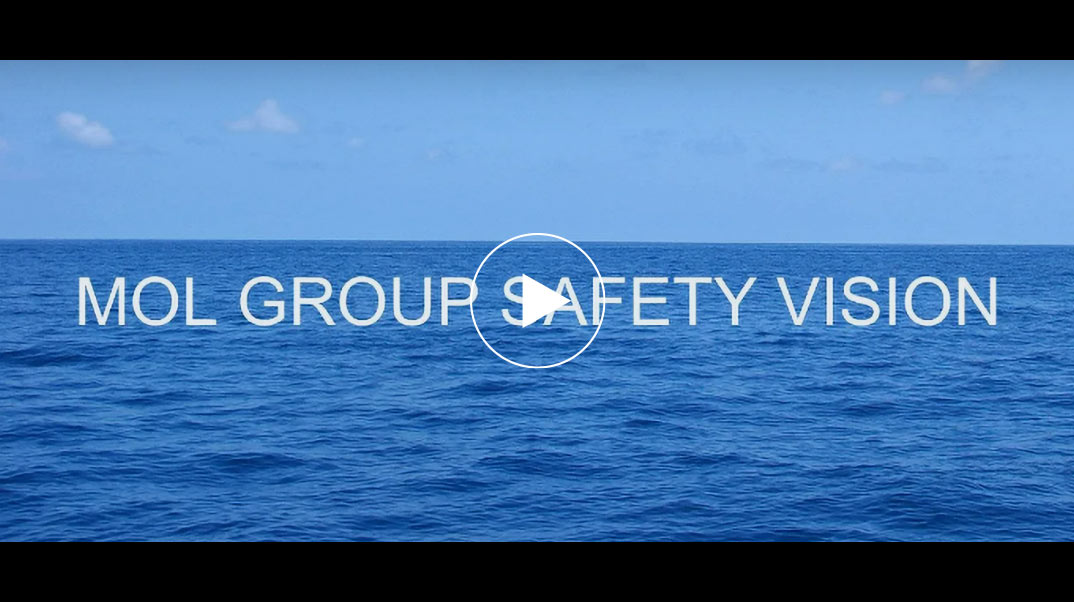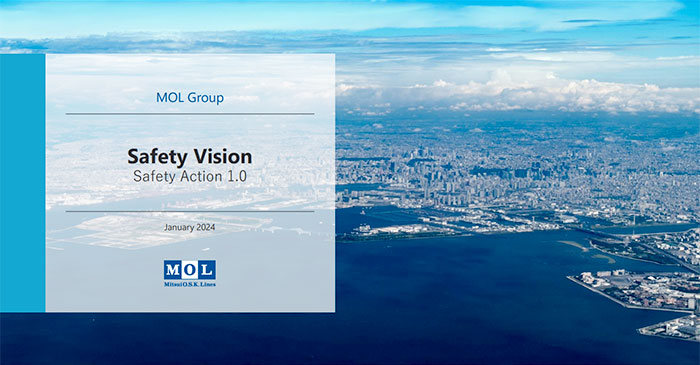- JP
- EN
MOL GroupSafety Vision
In order to ensure that the MOL Group can continue to protect precious people, property, and the environment and be trusted, the Group shall continue to support people's day-to-day fundamentals as part of its safety-focused operations as a responsible custodian of a social infrastructure business.

What we ought to be
Establishment of Safety Vision
The Safety Vision was established to both support "Safety & Value" as one of the sustainability issues for the MOL Group and to reinforce the 'S (for Safety)' aspect in the 'MOL CHARTS,' which sets out our values.
Moving forward, we will develop various social infrastructure businesses, primarily in the shipping business, with the aim of ensuring stable provision of services and delivering new growth. Safety will remain at the core of what we do. This Vision sets out the blueprint for safety in the MOL Group, under which we will undertake efforts to further reinforce our safety-related initiatives.
"Leading in Safety" embodies our commitment to driving forward safety levels across all industries by having each company within the MOL Group strive to ensure the world's highest level of safety and quality in their respective business fields. Moreover, it signifies how our executives and employees will actively lead on safety issues, rather than adopting a passive stance.


Safety Action 1.0
What we ought to be for safety is to continue to support people's day-to-day fundamentals as part of our safety-focused operations as a responsible custodian of our social infrastructure businesses.
In addition, what we ought to be is subdivided into people (executives, employees), work (working environment, processes), and organization (systems, functions), which are the components of the company, and each state of goal achievement is defined (see the figure above).
We define initiatives to make ourselves what we ought to be as "safety measures" and efforts to promote group-wide measures as "safety infrastructure" (collectively, Safety Action 1.0).
Specifically, safety measures divide into "promote the active participation of human capital to help ensure safety," "development of safety infrastructure centered on technology," and "preemptive management of risk and danger." The two categories for safety infrastructure are "reform safety awareness through mutual enlightenment" and "pursuit of the ideal organizational structure and business processes."

Index
KPI
We have set KPIs (and leading indicators) for the safety goals under the Safety Vision and KPIs for what we ought to be. This is predicated on the idea that our safety goals will ultimately be achieved by aiming to achieve KPIs for leading indicators and what we ought to be.
As KPIs for safety goals, group-wide KPIs for MOL group and safe operations KPIs are set respectively.
What we ought to be is also made up of the three elements of people (executives, employees), work (working environment, processes) and organization (systems, functions), which are the components of the company, and each with its own KPIs under the action plan.

- (*1) Define and set for each business segment in the MOL Group
- (*2) Safety Performance Indicator. The current targets (FY2025, FY2030, FY2035) are as follows: 1) 0.5 or less/0.4 or less/0.3 or less; 2) 24 or less/22 or less/20 or less; 3) 1.0 or less/0.8 or less/0.6 or less.
4 ZEROES
| Number of 4zeros accidents(*1) | FY2020 | FY2021 | FY2022 | FY2023 | |
|---|---|---|---|---|---|
| Number of accidents | 1(*2) | 3(*3) | 1 | 1 | |
| Breakdown | Number of serious marine incidents | 1 | 1 | 0 | 0 |
| Number of ocean oil pollution | 1 | 1 | 0 | 0 | |
| Number of fatal accidents | 0 | 2 | 1 | 1 | |
| Number of serious cargo damage | 0 | 1 | 0 | 0 | |
- (*1) The data covers about 800 MOL Group-operated vessels including MOL-managed and chartered vessels (and offshore projects).
We review the standards and scope of application as appropriate. - (*2) One accident occurred in FY2020, which was a serious marine accident and an ocean oil pollution.
- (*3) Three accidents occurred in FY2021, one of which was a serious marine accident, an ocean oil pollution, and a serious cargo damage.
SPI (Safety Performance Indicator)
| Targets and Achievements | FY2023 | ||
|---|---|---|---|
| Target | Achievement | Result | |
| LTIF(Lost Time Injury Frequency)(*1) | Less than 0.50 | 0.26 | Achieved |
| Average downtime(*2) | Less than 24.00 | 24.46 | Not Achieved |
| Downtime frequency rate(*3) | Less than 1.00 | 0.40 | Achieved |
- (*1) Number of lost time injuries occurring in a workplace per 1 million hours worked (MOL uses “on board time” as denominator). These figures include occupational injuries and illnesses that did not result in disembarkation but did not result in a return to work, including light work, on the day of the accident.
The indicator also covers seafarers outside of the MOL Group. The data includes MOL and its major domestic and overseas consolidated subsidiaries with the coverage ratio of 75% to consolidated revenue. - (*2) Annual incident-related stoppage hours per vessel.
- (*3) Annual number of incidents per vessel resulting in vessel stoppage.
- Sustainability TOP
- Message from the Chief Sustainability Officer
- Sustainability
Management - Value Creation
Stories - Safety & Value
- Environment
- Human & Community
- Innovation
- Governance
- Stakeholder
Engagement - Sustainable Finance
- Sustainability Data
- ESG Disclosure
Guideline Indexes - External Recognition
- Library




